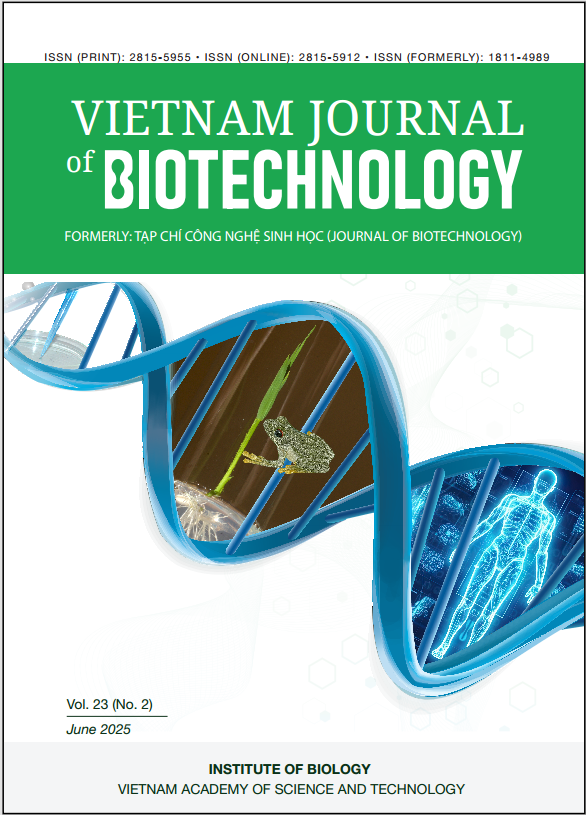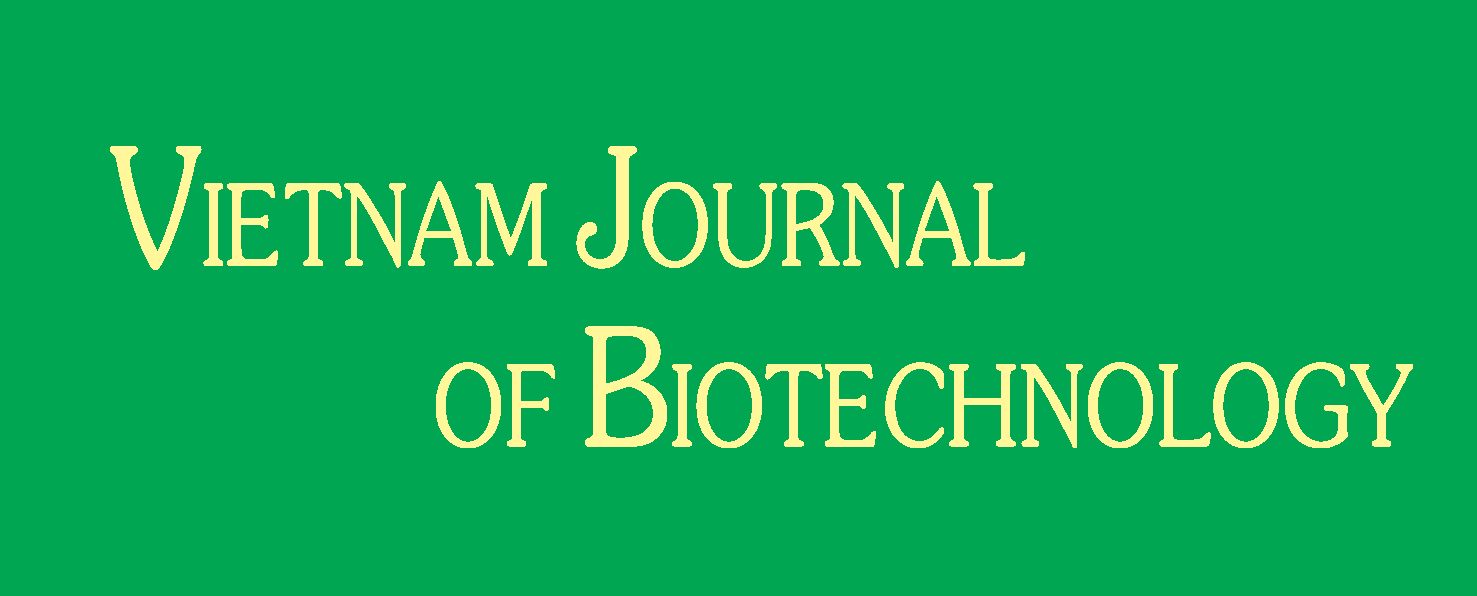Distribution of antibiotic resistance genes in marine water and sediments in aquaculture areas in Khanh Hoa, Vietnam
Author affiliations
DOI:
https://doi.org/10.15625/vjbt-22589Keywords:
Antibiotic resistance, antibiotic resistant gene, aquaculture areas, integron class 1, Khanh Hoa, East SeaAbstract
The emergence of antibiotic-resistant bacteria (ARB) and antibiotic resistance genes (ARGs) poses significant risks to ecological security and human health. Coastal areas affected by urban and aquaculture activities serve as critical reservoirs for pollutants, including ARGs. However, the data on the abundance and distribution of ARGs in marine sediments impacted by aquaculture activities in the East Sea, Vietnam, remain limited. This study investigated the distribution of ARGs across four aquaculture areas in the East Sea of Khanh Hoa province, Vietnam. The results revealed that sulfonamide-resistant genes, sul1 and sul2, were present at all sampling sites (100%), with abundance ranging from 2.4 × 102 to 2.0 × 105 copies/ml in seawater and from 2.0 × 105 to 2.57 × 107 copies/g in sediments. Tetracycline-resistant genes, including tetQ, tetM, and tetX, were detected at most sampling sites, with abundances ranging from 1.29 × 101 to 6.16 × 106 copies/ml in seawater and from 1.64 × 104 to 1.04 × 108 copies/g in sediments. The vancomycin-resistant gene (vanA) exhibited significant abundance, ranging from 1.38 × 103 to 3.22 × 104 copies/ml in seawater and from 1.14 × 106 to 1.9 × 107 copies/g in sediments. Finally, integron class 1 (intI1) was detected at all sampling sites (100%) in both seawater and sediments, with abundances up to 6.86 × 105 copies/ml in seawater and 2.06 × 108 copies/g in sediments. Given aquaculture's significant role in Vietnam's economic growth, implementing effective technologies and national policies to manage and mitigate antimicrobial resistance in aquaculture environments is crucial.
Downloads
References
Deng C., Liu X., Li L., Shi J., Guo W., and Xue J. (2020). Temporal dynamics of antibiotic-resistant genes and their association with the bacterial community in a water-sediment mesocosm under selection by 14 antibiotics. Environmental International, 137, 105554 https://doi.org/10.1016/j.envint.2020.105554.
Gillings M. R., Gaze W. H., Pruden A., Smalla K., Tiedje J. M., and Zhu Y-G. (2015). Using the class 1 integron-integrase gene as a proxy for anthropogenic pollution. The ISME Journal, 9, 1269–1279. https://doi.org/10.1038/ismej.2014.226
Hatosy S. M., Martiny A. C. (2015). The ocean as a global reservoir of antibiotic resistance genes. Applied and Environmental Microbiology, 81(21), 7593-7599. https://doi.org/10.1128/AEM.00736-15.
Hedberg N., Stenson I., Pettersson M. N., Warshan D., Nguyen-Kim H., Tedengren M., et al (2018). Antibiotic use in Vietnamese fish and lobster sea cage farms; implications for coral reefs and human health. Aquaculture, 495, 366-375. https://doi.org/10.1016/j.aquaculture.2018.06.005
Kraker M. E., Stewardson A. J., Harbarth S. (2016). Will 10 million people die a year due to antimicrobial resistance by 2050? PLoS Medicine, 13(11), e1002184. https://doi.org/10.1371/journal.pmed.1002184
Lu J., Wu J., Zhang C., Wang J., He X. (2024). Occurrence and possible sources of antibiotic resistance genes in seawater of the South China Sea. Frontiers of Environmental Science & Engineering, 18. https://doi.org/10.1007/s11783-024-1868-4
Mitchell M. E. V., Alders R., Unger F., Nguyen-Viet H., Le T. T. H., and Toribio J. A. (2020). The challenges of investigating antimicrobial resistance in Vietnam - what benefits does a One Health approach offer the animal and human health sectors? BMC Public Health, 20(1), 213. https://doi.org/10.1186/s12889-020-8319-3
Phu D. H., Wongtawan T., Truong D. B., Van C. N., Carrique-Mas J., Thomrongsuwannakij T. (2022). A systematic review and meta-analysis of integrated studies on antimicrobial resistance in Vietnam, with a focus on Enterobacteriaceae, from a One Health perspective. One Health, 15, 100465. https://doi.org/10.1016/j.onehlt.2022.100465.
Pitt S. J., Gunn A. (2024). The one health concept. British Journal of Biomedical Science, 81, 12366. https://doi.org/10.3389/bjbs.2024.12366.
Prestinaci F., Pezzotti P., Pantosti A. (2015). Antimicrobial resistance: A global multifaceted phenomenon. Pathogens amd Global Health, 109(7), 309-318. https://doi.org/10.1179/2047773215Y.0000000030
Quang Huy N., Bich Ngoc D., Thanh Tam T. T., Thu Hang L. T., Nhung D. T., Bañuls A.-L. (2023). Comparative genomics of carbapenem-resistant Pseudomonas aeruginosa strains sequence type 3151 isolated from two major hospitals in Hanoi, Vietnam. Vietnam Journal of Biotechnology, 21(4), 707–719. https://doi.org/10.15625/1811-4989/19961
Rodgers K., McLellan I., Peshkur T., Williams R., Tonner R., Hursthouse A. S., et al. (2019). Can the legacy of industrial pollution influence antimicrobial resistance in estuarine sediments? Environmental Chemistry Letters, 17(2), 595–607. https://doi.org/10.1007/s10311-018-0791-y
Siri Y., Precha N., Sirikanchana K., Haramoto E., Makkaew P. (2023). Antimicrobial resistance in southeast Asian water environments: A systematic review of current evidence and future research directions. Science of The Total Environment, 896, 165229. https://doi.org/10.1016/j.scitotenv.2023.165229
Tran H. S., Vu D. Q., Nguyen D. Q., Bui D. T., Do T. U., Le T. T. H., et al. (2025). Occurrence of multidrug-resistant Enterobacteriaceae and antibiotic-resistant genes in the anthropogenic impacted bay of Nha Trang, Viet Nam. Regional Studies in Marine Science, 83. https://doi.org/10.1016/j.rsma.2025.104084
Van Anh N., Thuy Duong N., Thanh Tam T. T., Quang Huy N. (2023). Resistome and plasmidome in an extensively drug-resistant extra-intestinal pathogenic Escherichia coli isolated from a one-year-old child with respiratory distress syndrome. Vietnam Journal of Biotechnology, 21(2), 305–316. https://doi.org/10.15625/1811-4989/18671
Wang S., Nie W., Gu Q., Wang X., Yang D., Li H., et al. (2024). Spread of antibiotic resistance genes in drinking water reservoirs: Insights from a deep metagenomic study using a curated database. Water Research, 256, 121572. https://doi.org/10.1016/j.watres.2024.121572
WHO, (2020). 10 global health issues to track in 2021. https://www.who.int/news-room/spotlight/10-global-health-issues-to-track-in-2021.
WHO, (2023). Everyone has a responsibility to prevent Antimicrobial Resistance in Viet Nam. https://www.who.int/vietnam/news/detail/20-11-2023-everyone-has-a-responsibility-to-prevent-antimicrobial-resistance-in-viet-nam
Zhang Z., Zhang Q., Wang T., Xu N., Lu T., Hong W., et al. (2022). Assessment of global health risk of antibiotic resistance genes. Natural Communication, 13, 1553. https://doi.org/10.1038/s41467-022-29283-8







